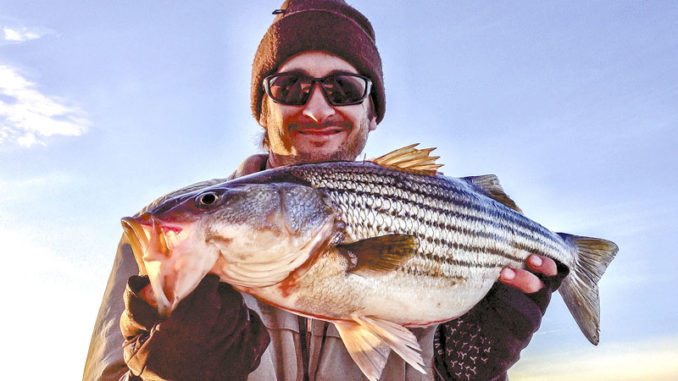
Jigging around channel markers, trolling, casting to schooling fish all work just fine.
The striped bass is a hands-down favorite among cool-water fisherman looking to heat things up in eastern North Carolina, and there’s no place better than the Albemarle Sound to light the fire.
Whether casting, jigging, or trolling, anglers can get in on the action about any way they please if they know what to look for. According to guide Jeff Onley of Elizabeth City, N.C., it’s all about finding the right structure and pairing the right technique with it.
One such structure that Onley (252-333-6524), who runs Albemarle Fishing Charters, prefers in November is the sound’s channel markers. Typically targeting the area between the Chowan River and the North River in 7 to 18 feet of water, Onley pulls up beside a pole and drops a ¾-ounce Stingsilver or Hopkins spoon. After bumping it off the bottom, he jigs the lure alongside the pole while testing various depths until met with a thump.
“By November, they could be moving into the mouths of the rivers,” Onley said. “That’s where I’ll target structures like piers, casting a 3⁄4-ounce Rat-L-Trap or a 3- to 4-inch Berkley swimming mullet. My colors are blue and silver in the Rat-L-Traps and chartreuse and white in the swimming mullets. There are also rock piles you can cast over in the mouth of the Pasquotank River where the old lighthouses used to sit.”
If an angler is unfamiliar with an area, trolling the shoreline’s numerous stump fields is a good way to cover ground. The same Rat-L-Traps Onley uses for casting also make solid trolling baits, as well as Rapala Husky Jerks. Stump fields can be found with sonar, and those in 9 to 10 feet of water are preferred because the baits will usually ride above the wood at a speed around 2 knots. The Albemarle Sound bridge is also an excellent trolling area, but Onley switches to Yozuri Deep Divers and Mann’s Stretch 20s in the deeper water.
If an angler spots birds diving into baitfish being pushed to the surface, he is fortunate enough to have located schooling fish and should get there as quickly as possible.
“Some people like to troll around or to cast to schooling fish,” Onley said. “But the way to catch the bigger fish is to stop on the school and drop over Hopkins or Stingsilvers. Drop it to the bottom and jig it. If you let the school pass on by, that’s usually where the bigger fish will be, not under the birds.”
Onley prefers fishing 40-pound Power Pro braidwithout a leader on a 6½-foot spinning rod matched with a 2000 class spinning reel.



Be the first to comment